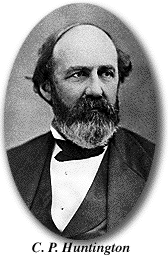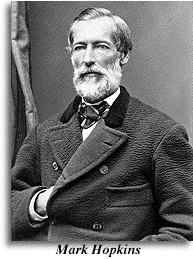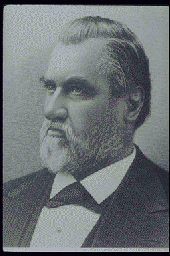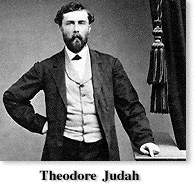Biographies
of the Leaders of the Central Pacific Rail Road Company
 Collis P. Huntington
was born in Harwinton, Connecticut on October 22, 1821. His father
was a farmer and small manufacturer. At the age of 14, Huntington
left home to fend for himself, earning 84 dollars plus board and
clothing for the entire year. He saved every penny, "an early
indication of his extraordinary thrift, patience, and determination"
[Kraus 294].
Collis P. Huntington
was born in Harwinton, Connecticut on October 22, 1821. His father
was a farmer and small manufacturer. At the age of 14, Huntington
left home to fend for himself, earning 84 dollars plus board and
clothing for the entire year. He saved every penny, "an early
indication of his extraordinary thrift, patience, and determination"
[Kraus 294].
Huntington entered into business with his eldest brother as general
merchants in Oneonta, New York at the age of 22. In 1849, he finally
left the business to set out for San Francisco with his wife and many
other forty-niners. He reached the Isthmus of Panama but was detained
for three months, along with many others headed for California,
waiting for a northbound ship. Rather than do nothing during this
time, Huntington bought and sold merchandise, walking back and forth
across the Isthmus 24 times in the process. He left for California
with $1200 and arrived with $5000. [Kraus 294]
Once in Sacramento, Huntington started a store out of a small tent
and very soon thereafter entered into a partnership with Mark Hopkins. Their enterprise was so successful
the firm was one of the wealthiest on the Pacific coast by 1856. Theodore Judah convinced Huntington and Hopkins to undertake the first transcontinental
railroad in their store on K street. [Kraus 294]
Huntington played a key role in recruiting the other two members of
the Big Four, namely Leland Stanford and Charles Crocker. He later said "in a general way,
I believe that every member of the company came in at my personal
solicitation. I spent many evenings until a late hour -- after
getting through my regular business -- in going to see men, and I
believe I went to see only those who were thrifty, and those I
believed to be safe business men." [Kraus 294]
In their railroad enterprise, Huntington ensured that all obligations
were promptly met and that the Central Pacific's bonds were among the
best in the world with his skillful management. He was a "hard,
unyielding man who stopped at nothing to achieve his goal" [Kraus 294].
However, to his family, he was "genial, good-humored, companionable, and
a dreamer" [Kraus 294]. Huntington remarried after his first wife died
in 1884. Since he had no children, he adopted a son, Archer, and a
daughter, Clara.
Huntington made many enemies during his career, with newspapers among
his most bitter critics. He had said "I am rather proud of the enemies
I have made. All I ask is that they do not praise me, for then my
friends would say: 'What has Huntington been doing now, that such
fellows would praise him?'" [Kraus 295]. "Despite his great wealth and
power, innumerable interests, and the controversies that constantly
revolved about him, Huntington always spoke out strongly for the working
man and insisted on a day's pay for a day's work. He also had a high
regard for the public" [Kraus 295]. Collis Huntington died on August
13, 1900, at the age of 78.
 Mark Hopkins
was born on September 1, 1813, in Henderson, New York to a family of
Puritan stock. In 1825, his family moved to St. Clair, Michigan. He
started his business career as a clerk in a mercantile company at the
age of 16, first in Niagra County, New York and then at Lockport as a
leading partner in Hopkins & Hughes. He began studying law in 1837, but
"sold out" and went to San Francisco in 1849. He opened a store in
Placerville a few months later and hauled his own goods from Sacramento
with an ox team. He opened a wholesale grocery business the next year
with E. H. Miller, Jr. He entered into partnership with Collis P. Huntington in 1855 in Sacramento, and
remained a member of that firm until his death. [Kraus 295]
Mark Hopkins
was born on September 1, 1813, in Henderson, New York to a family of
Puritan stock. In 1825, his family moved to St. Clair, Michigan. He
started his business career as a clerk in a mercantile company at the
age of 16, first in Niagra County, New York and then at Lockport as a
leading partner in Hopkins & Hughes. He began studying law in 1837, but
"sold out" and went to San Francisco in 1849. He opened a store in
Placerville a few months later and hauled his own goods from Sacramento
with an ox team. He opened a wholesale grocery business the next year
with E. H. Miller, Jr. He entered into partnership with Collis P. Huntington in 1855 in Sacramento, and
remained a member of that firm until his death. [Kraus 295]
When the Central Pacific Rail Road Company was organized, Hopkins
became the treasurer. Every project the Big Four embarked on was
submitted to Hopkins for his final approval. All had implicit faith in
his judgment, honesty, and integrity. He was described as a
"thoughtful, quiet man of rather slender build, who ... spoke with a
slight lisp". Neither colorful nor dynamic, Hopkins was described by his
associates as "one of the truest and best men that ever lived". Collis
Huntington remarked that he "never thought anything finished until
Hopkins looked at it, which is praise enough". [Kraus 295].
Hopkins died on March 29, 1878 at the age of 64 in Yuma Arizona.
 Leland Stanford
was one of seven sons of Josiah Stanford, who farmed near Watervliet,
New York (on the stage road between Albany and Schenectady). Stanford
spent his early years as a typical farm boy and mediocre student. Also
during this time, he entered into his first business ventures with his
brothers, selling horseradish in Schenectady and chestnuts in Albany.
He had his first experiences with railroads when his father graded
a part of the railroad (only 15 miles long) between Albany and
Schenectady in 1829. [Kraus 296]
Leland Stanford
was one of seven sons of Josiah Stanford, who farmed near Watervliet,
New York (on the stage road between Albany and Schenectady). Stanford
spent his early years as a typical farm boy and mediocre student. Also
during this time, he entered into his first business ventures with his
brothers, selling horseradish in Schenectady and chestnuts in Albany.
He had his first experiences with railroads when his father graded
a part of the railroad (only 15 miles long) between Albany and
Schenectady in 1829. [Kraus 296]
At the age of 20, he began to study law at the office of Wheaton,
Doolittle & Hadley in Albany. He financed his education with $2000 he
made by selling timber cleared from the land near the railroad. He was
admitted to practice in the Supreme Court of New York after staying with
the firm for three years. [Kraus 296]
Stanford married Jane Lathrop and moved to Port Washington in
northern Wisconsin to practice law. In 1852, his office and his legal
books burned. Since he was almost broke, he sent his wife to live with
her parents and went to California, ending up in the mining village of
Michigan Bluff. He searched for gold, but found nothing. He then
entered into business with two of his brothers, who had gone to
California in 1849 when the gold rush began. He had become sufficiently
wealthy within four years to be regarded as one of the leading citizens
of th mining region. So he entered into a dry-goods-store business in
Sacramento. [Kraus 296]
During his early years in California, Stanford earned the reputation
of a fair man, and often arbitrated in disagreements among miners. He
began his political career as the Free Soil Party's candidate for
treasurer in 1857. Two years after this defeat, he was nominated by the
party for governor. He was again defeated, but his influence spread
beyond California when the party sent him to the Chicago convention as
its candidate. Abraham Lincoln was nominated for the presidency, but he
and Stanford shared a warm friendship. Stanford stayed in Washington
after Lincoln's inauguration. During this time, some say that Stanford
"exerted silent but powerful influence upon national policies affecting
the Pacific Coast" [Kraus 296]. When he returned to Sacramento, he was
nominated for governor by the Republican Party in 1861 and elected by a
large majority for a two-year term. He was selected as one of the
backers of the Central Pacific in 1860, at least in part because of his
growing power and popularity. Stanford then became the first president
of the Central Pacific. [Kraus 296]
Stanford began pursuing other interests after the Southern Pacific
(formerly the Central Pacific) finished its second transcontinental line
from New Orleans, across the deserts of Texas, Arizona, and into
California. He bought about half a million acres of California farmland
and his ranch at Vina produced the largest vineyard in the world. His
favorite ranch was in Palo Alto, where he founded a university with a
grant of 20 million dollars in honor of his son, Leland Stanford Jr.,
who died in Florence, Italy, in 1884. Stanford died at Palo Alto on
June 21, 1893. [Kraus 296]
Charles Crocker
was born September 16, 1822 in Troy, New York. When he was ten years
old, he delivered newspapers to earn money to help his father purchase a
farm in Indiana. The family moved there in 1836, where Crocker helped
to clear and cultivate the land for two years before he went to work in
a sawmill and, later, at a forge for eleven dollars a month (with
board). He attended the district school during the winter and later
started his own forge, which became fairly successful. He went across
the plains to California in 1850, where he established a dry-goods store
in Sacramento after trying his hand at mining for two years. In 1860,
he was elected to the state legislature as a member of the Republican
Party, but gave up the office (and his dry-goods store) after one term
to "devote himself and his money to the Pacific Railroad Enterprise"
[Kraus 297].
Under Crocker's direction, the Central Pacific constructed it's part
of the railroad seven years ahead of schedule. He was the ideal leader
for a great working force, such as was found working on the railroad.
He was a cheerful man who "had a rare gift for imparting his own
enthusiasm to others" [Kraus 296]. He also helped build the Southern
Pacific's transcontinental line across the Southwest and founded other
firms, such as the Crocker Bank. Additionally, he helped to develop
California, particularly in the Merced area. Crocker died in Monterey
on August 14, 1888. [Kraus 297]
 Theodore D. Judah
was born on March 4, 1826 in Bridgeport, Connecticut to an Episcopal
minister. Judah studied engineering at Rensselaer Polytechnic Institute
after his family moved to Troy, New York. His first experience with
railroading occurred when he worked on a line being laid from Troy to
Schenectady. He realized that he had found his career and he never left
it. He married at the age of 22 and went to California at the age of
28 to become the chief engineer of the Sacramento Valley Railroad,
planned to operate between Sacramento and one of the mining districts
east of the town. [Kraus 297]
Theodore D. Judah
was born on March 4, 1826 in Bridgeport, Connecticut to an Episcopal
minister. Judah studied engineering at Rensselaer Polytechnic Institute
after his family moved to Troy, New York. His first experience with
railroading occurred when he worked on a line being laid from Troy to
Schenectady. He realized that he had found his career and he never left
it. He married at the age of 22 and went to California at the age of
28 to become the chief engineer of the Sacramento Valley Railroad,
planned to operate between Sacramento and one of the mining districts
east of the town. [Kraus 297]
Judah was the driving force behind California's role in the
construction of the Pacific Railroad; it was one of his major
enthusiasms. He had a dream of a railroad that would cross the
continent, and talked about his dream to anyone who would listen. His
obsession, in part, led to the meeting of the Pacific Railroad
Convention in 1859, which was the beginning of the major push for a
transcontinental railroad. [Kraus 297]
After he completed his work on the Sacramento Valley Railroad in 1856
(the first railroad in California), Judah continued to rally for the
Pacific Railroad. His enthusiasm eventually led to the founding of the
Central Pacific Rail Road Company and his lobbying efforts made the
passage of the Pacific Railroad Bill of 1862 possible. While the
passage of this bill made his dream of a Pacific Railroad possible, he
died in November of 1863, before his dream could be fulfilled. [Kraus 297]
James Harvey Strobridge
was born on April 23, 1827 to an old New England family in Albany,
Vermont. At the age of 16, he left home to work as a tracklayer for the
Boston and Fitchburg Railroad in Massachusetts, and later contracted to
build two miles of line for the Naughatuck Railroad in Connecticut. He
joined the gold rush in 1849, sailing to the west. Once in California,
he worked as a hay-cutter on a Sacramento Valley ranch until the summer
of 1850, when he worked by freighting supplies to the mines. After
three months of freighting, he began mining in Placerville and Coon
Hollow. [Kraus 297]
In 1863, Strobridge worked on the San Francisco and San Jose
Railroad. In 1864, he joined the Central Pacific and was quickly placed
in charge of the entire construction program. He was "a man of ability,
command, willingness to take responsibility, and initiative under adverse
circumstances" [Kraus 297].
Strobridge settled on a farm near Hayward after the Golden Spike
ceremony in 1869, and, for a number of years, construction was carried
on by others (subsidiary companies, or by contract). Crocker brought
Strobridge back to work on the second transcontinental line (from Los
Angeles to New Orleans) in 1877 under the condition that Strobridge
would not live on the site, as he had for the first railroad, but would
"organize the work and visit as often as necessary" [Kraus 298]. He
later built a line from Mojave to Needles and began the line up the
Sacramento River Canyon toward Oregon in 1883. He continued in this
capacity until 1889, when he again retired to his farm. He died on July
27, 1921. [Kraus 298]
 Collis P. Huntington
was born in Harwinton, Connecticut on October 22, 1821. His father
was a farmer and small manufacturer. At the age of 14, Huntington
left home to fend for himself, earning 84 dollars plus board and
clothing for the entire year. He saved every penny, "an early
indication of his extraordinary thrift, patience, and determination"
[Kraus 294].
Collis P. Huntington
was born in Harwinton, Connecticut on October 22, 1821. His father
was a farmer and small manufacturer. At the age of 14, Huntington
left home to fend for himself, earning 84 dollars plus board and
clothing for the entire year. He saved every penny, "an early
indication of his extraordinary thrift, patience, and determination"
[Kraus 294].


